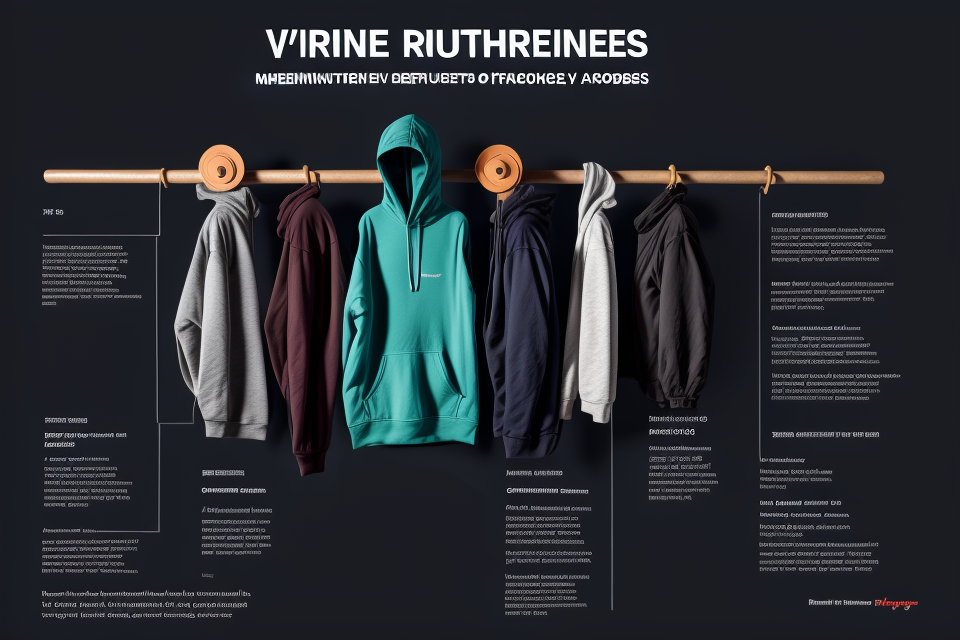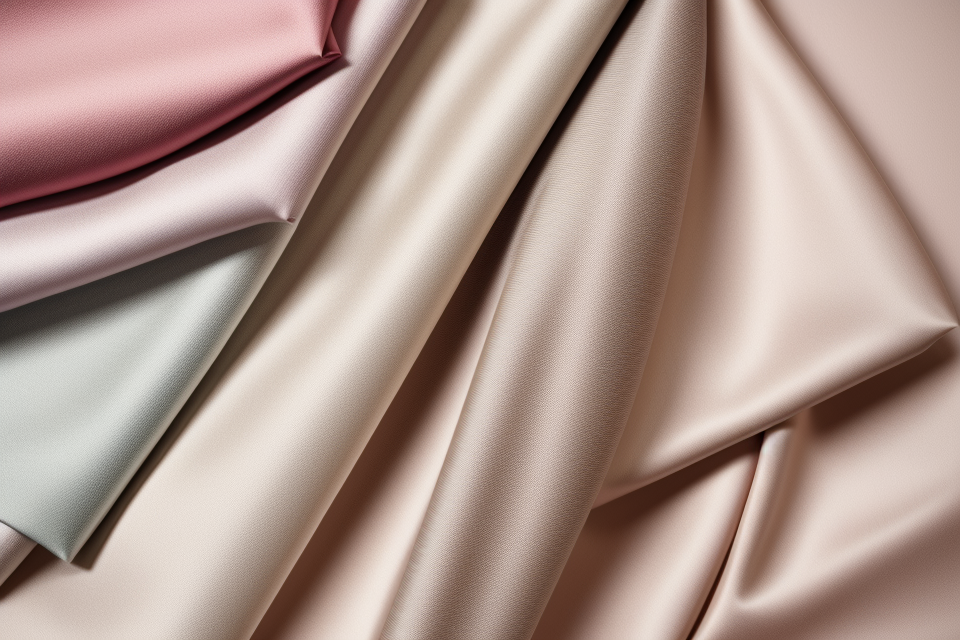
Hoodies have become a staple in everyone’s wardrobe, but have you ever wondered what kind of material is used to make them? With so many options available, choosing the right fabric for your hoodie can be overwhelming. In this guide, we will explore the different types of materials used to make hoodies, their properties, and how to choose the right one for you. Whether you’re looking for comfort, durability, or style, this guide has got you covered. So, let’s dive in and discover the world of hoodie materials!
What is Hoodie Material?
Definition of Hoodie Material
Hoodie material refers to the fabric used to create hooded sweatshirts, which are popular clothing items among people of all ages. The material used for hoodies can vary widely, from lightweight and breathable fabrics to heavy and insulating materials.
Different Types of Hoodie Material
There are several types of hoodie material available in the market, each with its own unique properties and benefits. Some of the most common types of hoodie material include:
- Cotton: Cotton is a popular choice for hoodie material due to its softness, breathability, and durability. It is also relatively inexpensive and easy to care for.
- Polyester: Polyester is a synthetic fabric that is known for its strength, durability, and resistance to wrinkles. It is often used in hoodies that require a more fitted or stretchy feel.
- Fleece: Fleece is a type of synthetic fabric that is designed to be warm and insulating. It is often used in hoodies that are intended for outdoor activities or colder climates.
- Satin: Satin is a glossy, smooth fabric that is often used for hoodies that have a fashionable or luxurious feel. It is generally not as warm as other materials, but it can be layered for added insulation.
- Blends: Many hoodies are made from blends of different fabrics, such as cotton and polyester or cotton and fleece. These blends can offer the best of both worlds, with the softness and breathability of cotton and the warmth and durability of polyester or fleece.
Overall, choosing the right hoodie material depends on a variety of factors, including personal preference, intended use, and the climate in which the hoodie will be worn. By understanding the different types of hoodie material available, you can make an informed decision when selecting a hoodie that meets your needs and preferences.
Factors to Consider When Choosing Hoodie Material
Comfort
When choosing hoodie material, comfort should be a top priority. The fabric should be soft and lightweight, allowing for a comfortable fit that won’t weigh you down. It should also be breathable, allowing for airflow and preventing you from overheating. Look for fabrics that are made from natural fibers such as cotton or bamboo, as they tend to be softer and more comfortable than synthetic materials.
Durability
Another important factor to consider when choosing hoodie material is durability. The fabric should be able to withstand regular wear and tear, as well as washing and drying without shrinking or losing its shape. Look for fabrics that are made from high-quality materials that are known for their durability, such as polyester or nylon. It’s also a good idea to look for hoodies with reinforced stitching in high-stress areas, such as the hood and cuffs.
Appearance
The appearance of the hoodie material is also an important consideration. Look for fabrics that are smooth and free of imperfections, as they will look and feel better than rough or textured fabrics. Consider the color and pattern of the fabric as well, as they can greatly affect the overall appearance of the hoodie. If you’re unsure about the color or pattern, it’s always a good idea to choose a neutral color that can be easily paired with a variety of outfits.
Seasonality
When choosing hoodie material, it’s important to consider the seasonality of the fabric. For example, a lightweight, breathable fabric like cotton is best for spring and summer, while a thicker, warmer fabric like fleece is better for fall and winter. Look for fabrics that are designed to keep you warm or cool, depending on the season, and choose a hoodie that is appropriate for the weather conditions you’ll be wearing it in.
Functionality
Finally, consider the functionality of the hoodie material. Look for fabrics that are moisture-wicking, allowing sweat to evaporate quickly and keep you dry and comfortable. It’s also a good idea to choose a hoodie with pockets, as they can be convenient for storing items like your phone or keys. Consider the purpose of the hoodie as well, as some fabrics may be better suited for certain activities, such as hiking or running.
Common Hoodie Materials
Cotton
Cotton is a popular choice for hoodie material due to its softness, breathability, and durability. It is a natural fiber that is derived from the cotton plant, and it is known for its ability to wick moisture away from the body. Cotton hoodies are often preferred by people who live in warmer climates or those who are sensitive to synthetic fabrics. However, cotton hoodies may not be as warm as other materials, and they may shrink if not washed properly.
Polyester
Polyester is a synthetic fiber that is known for its strength, durability, and resistance to wrinkles. It is a popular choice for hoodie material because it is lightweight, moisture-wicking, and easy to care for. Polyester hoodies are often used in activewear and outdoor clothing because they can withstand rough wear and tear. However, they may not be as breathable as cotton or other natural fibers.
Fleece
Fleece is a synthetic fabric that is made from polyester or other synthetic fibers. It is known for its warmth, softness, and insulating properties. Fleece hoodies are often used in cold weather clothing because they can trap warm air and keep the body insulated. They are also lightweight and easy to care for, making them a popular choice for outdoor activities and everyday wear.
Denim
Denim is a heavyweight fabric that is made from cotton or a blend of cotton and other fibers. It is known for its durability and classic style, and it is often used in jackets and other outerwear. Denim hoodies are less common than other materials, but they can be a stylish and rugged choice for those who want a unique look. However, denim hoodies may be heavier and less breathable than other materials.
Satin
Satin is a smooth and shiny fabric that is made from silk or a synthetic material. It is known for its luxurious feel and its ability to drape well on the body. Satin hoodies are less common than other materials, but they can be a glamorous and sophisticated choice for special occasions or as part of a uniform or costume. However, satin hoodies may be more delicate and require more care than other materials.
Choosing the Right Hoodie Material for Your Needs
Step 1: Determine Your Budget
Before making a decision on the material for your hoodie, it is important to determine your budget. Hoodie materials come in a wide range of prices, from affordable to expensive. Your budget will help you narrow down your options and make a more informed decision.
Step 2: Consider Your Lifestyle
Your lifestyle is another important factor to consider when choosing the material for your hoodie. If you lead an active lifestyle, you may want to choose a material that is durable and can withstand wear and tear. On the other hand, if you prefer a more laid-back lifestyle, a lightweight and comfortable material may be more suitable.
Step 3: Decide on the Type of Hoodie You Want
The type of hoodie you want will also play a role in determining the material. For example, if you want a classic cotton hoodie, you will need to choose a material that is suitable for cotton. If you want a hoodie with a more unique design, you may need to choose a material that is less common, such as bamboo or Tencel.
Step 4: Check the Care Instructions
It is important to check the care instructions for the material you are considering. Some materials require special care, such as washing in cold water or air-drying. This information will help you ensure that you can properly care for your hoodie and maintain its quality over time.
Step 5: Make Your Decision
After considering your budget, lifestyle, hoodie type, and care instructions, you are ready to make your decision. Keep in mind that the material you choose will have a significant impact on the comfort, durability, and overall quality of your hoodie. With this comprehensive guide, you should be able to choose the right material for your needs and create a hoodie that you will love for years to come.
Recap of Key Points
When choosing the right hoodie material for your needs, there are several key points to consider. Firstly, it is important to consider the type of fabric you want your hoodie to be made from. Some popular options include cotton, polyester, and fleece. Each of these fabrics has its own unique properties, such as breathability, moisture-wicking ability, and insulation.
Next, you should consider the intended use of your hoodie. For example, if you plan to wear your hoodie for outdoor activities, you may want to choose a fabric that is specifically designed for that purpose. On the other hand, if you simply want a comfortable hoodie to wear around the house, a different type of fabric may be more suitable.
Additionally, you should consider the season in which you will be wearing your hoodie. For example, if you plan to wear it during the colder months, you may want to choose a fabric that is specifically designed to keep you warm. Conversely, if you plan to wear it during the warmer months, you may want to choose a lighter weight fabric that is more breathable.
Lastly, you should consider your personal preferences when it comes to hoodie material. Do you prefer a specific texture or feel? Do you have any allergies or sensitivities to certain fabrics? These are all important factors to consider when choosing the right hoodie material for your needs.
Final Thoughts on Choosing the Right Hoodie Material
When it comes to choosing the right hoodie material, there are a few key things to keep in mind. First and foremost, consider the intended use of the hoodie. If you plan to wear it for outdoor activities, such as hiking or camping, then a fabric that is durable and moisture-wicking is essential. On the other hand, if you’re looking for a hoodie to wear as a casual, everyday garment, then comfort and style may be your top priorities.
Another important factor to consider is the fabric’s weight. Heavier fabrics, such as denim or corduroy, are typically warmer and more durable, but may also be more expensive and less comfortable. Lighter fabrics, such as cotton or silk, are generally more affordable and comfortable, but may not provide as much warmth or durability.
Finally, don’t forget to consider the care instructions for the fabric. Some fabrics require special care, such as dry cleaning only, while others can be machine washed and dried. Make sure to read the care instructions carefully before making your final decision.
In conclusion, choosing the right hoodie material requires careful consideration of your needs and preferences. Whether you prioritize durability, comfort, style, or affordability, there is a hoodie material out there that is perfect for you. With this comprehensive guide, you’ll be able to make an informed decision and find the perfect hoodie for your needs.
FAQs
1. What is hoodie material made of?
Hoodie material can be made from a variety of fabrics, including cotton, polyester, fleece, and blends of these materials. The choice of fabric will depend on the desired weight, warmth, and texture of the hoodie.
2. What is the difference between cotton and polyester hoodies?
Cotton hoodies are made from natural fibers and are typically lighter and more breathable than polyester hoodies. Polyester hoodies, on the other hand, are made from synthetic fibers and are generally warmer and more durable than cotton hoodies. They also tend to be more resistant to shrinking and wrinkling.
3. What is fleece material?
Fleece material is a type of synthetic fabric that is made from polyester or other synthetic fibers. It is known for its softness, warmth, and ability to wick moisture away from the body. Fleece hoodies are often used as a layering piece in colder weather.
4. What are the benefits of wearing a hoodie made from cotton?
Cotton hoodies are lightweight and breathable, making them a good choice for layering or for wearing on warmer days. They are also generally more comfortable than synthetic fabrics and are often more affordable than other types of hoodies.
5. What are the benefits of wearing a hoodie made from polyester?
Polyester hoodies are warm and durable, making them a good choice for colder weather or for people who need a hoodie that can withstand a lot of wear and tear. They are also generally more affordable than cotton hoodies and can be easily cared for by machine washing and drying.
6. What are the benefits of wearing a hoodie made from fleece?
Fleece hoodies are soft and warm, making them a good choice for layering in colder weather. They are also highly breathable and can wick moisture away from the body, making them a good choice for activities like skiing or running.
7. Can I wash my hoodie in the washing machine?
Yes, most hoodies can be washed in the washing machine. However, it is important to check the care label on your hoodie to see if it has any specific washing instructions. Some hoodies may need to be washed by hand or may require special care like tumble drying on a low heat setting.
8. How should I care for my hoodie?
The care instructions for your hoodie will depend on the type of fabric it is made from. In general, it is a good idea to avoid using bleach or fabric softener on your hoodie, as these can damage the fabric. You should also avoid ironing your hoodie unless it is specifically labeled as iron-safe. It is always a good idea to check the care label on your hoodie for specific instructions.


